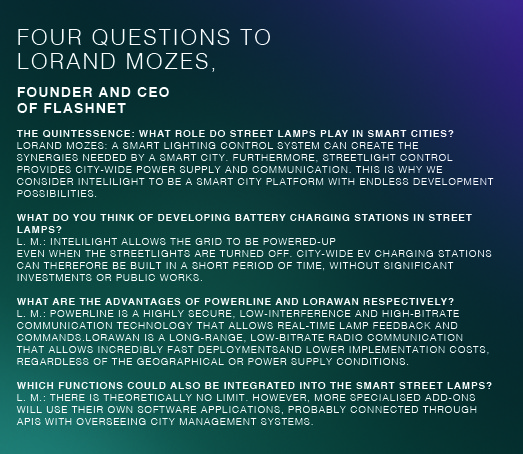Street lamps are becoming multi-function stations for smart cities. They can be used as charging stations for electric vehicles, WLAN nodes, measuring stations or emergency telephones.
In Europe alone, around ten million street lamps will be replaced or repaired over the next few years. This modernisation now gives local authorities the chance to go beyond saving energy and costs and to develop innovative, digital urban infrastructure. Street lamps are becoming multi-functional masts: equipped with everything from public WLAN, emergency call functions, sensors for measuring pollutants and CO2, traffic flow measurement and control instruments right through to charging stations for electric vehicles, they are accelerating the digitisation of the urban environment. Citizens and companies can use the anonymised information for innovative applications. As a result, it may be possible to increase safety and convenience on the streets, use energy intelligently and collect compliance data for critical pollutants, for example. “Replacing bulbs with LEDs is not enough. With digitised street lighting, we are creating the Smart City,” explains Dr Lutz Heuser, CEO of the Urban Software Institute – a software and consulting company which sees itself as an incubator for Smart City solutions.
Light on demand
The Dutch municipality of Schiedam, for example, has equipped two streets with intelligent street lighting from the company Tvilight. Wireless sensors on the street lamps detect whether a pedestrian, cyclist or car is approaching and adjust the light accordingly. If someone is in the vicinity of the lamp, it powers up and if the street is empty, it dims – this effect is known as “light on demand”. “The municipality places a great deal of importance on sustainability in all urban projects,” underlines Jean-Marc Pisters from the municipality of Schiedam. “As we had to modernise the lighting for one of the most major streets in the city, we opted for intelligent street lighting. It allows us to save energy and increase public safety.” Public lighting accounts for around 60 per cent of electricity costs in European cities.
Multi-functional service stations
However, street lamps can do so much more than simply bringing light to the dark. The power company EnBW is demonstrating this with its intelligent, multi-functional street lighting. As well as being an efficient LED light, Sm!ght is also a WLAN hotspot for wireless Internet access, a charging station for electric vehicles, an emergency telephone for those seeking assistance and a measuring station for environmental data. Azure, the cloud platform from Microsoft, forms the technical basis for networking the lamps and their sensors and for processing the data. “With Sm!ght, we are showing how modern lamps can offer many more functions than just efficient light,” says Uli Huener, Head of Innovation Management at EnBW, who is responsible for the in-house development. “With modern sensors and the right cloud technology, we can develop multi-functional service stations from simple lamps.” The sensors installed on the masts therefore provide information about particulates and link these with weather data to reduce the environmental impact by adjusting the traffic management measures, for example. What‘s more, the mobile phones registered to the hotspot transmit useful data which can be used to guide flows of people during sporting events and fairs. The first of these smart lamps are already in place in Karlsruhe and other towns across the state of Baden-Württemberg, Germany.
Using the old infrastructure
The key aspect for local authorities, whose budgets are often restricted, is that no new lamps need to be installed to make the street lighting fit for a Smart City. Brasov is a prime example of this: the seventh largest town in Romania, and one of its most significant tourist destinations, has not replaced the existing infrastructure but has “just” updated it instead. This is because the budget available was not enough to replace the approximately 12,000 high-intensity discharge lamps with LED ones. Therefore, the primary objective was to improve the management of the existing infrastructure. However, at the same time, the surveillance cameras and panic buttons installed on the masts should improve safety for the citizens. The Intellilight system from the Romanian company Flashnet has been used for this purpose since 2015. As well as providing LoRaWAN as a communication system for modern street lighting solutions, the company also offers communication via the power lines. In this instance, the data is not transmitted wirelessly, rather via the existing power cables which supply the lamps with energy. This means the data transfer is also well protected against electromagnetic inference, which is emitted from the old HID lamps. The lighting control software does not just monitor the power consumption of each individual lamp so that defects can be detected quickly – it also ensures that the network is supplied with energy 24 hours a day. This means that there is always enough power available for the cameras and panic buttons installed on some of the lamp masts. What’s more, the data is transferred to the control centre via the power lines. Brasov has also equipped some masts with charging stations for electric vehicles – and has done all of this without having to lay new power cables or construct new lamps.

